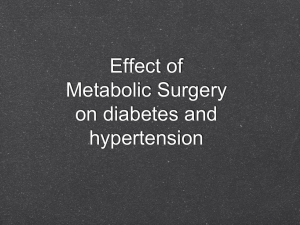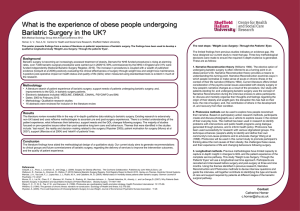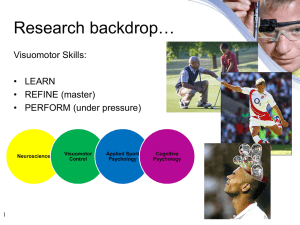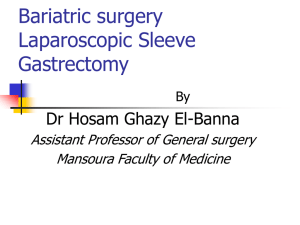Pharmacotherapy of Obesity
advertisement
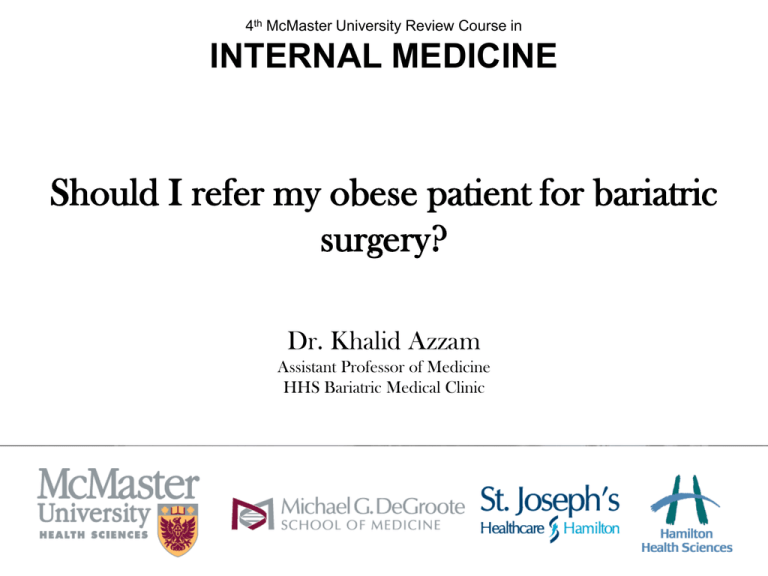
4th McMaster University Review Course in INTERNAL MEDICINE Should I refer my obese patient for bariatric surgery? Dr. Khalid Azzam Assistant Professor of Medicine HHS Bariatric Medical Clinic 4th McMaster University Review Course in INTERNAL MEDICINE Dr. Khalid Azzam has NO potential for conflict of interest with this presentation One in Four Adult-Canadians is Obese Component of Statistics Canada Catalogue no. 82-625-X Health Fact Sheets. www.statcan.gc.ca/chms. Obesity Etiology • Majority of obese subjects are affected by common obesity of multifactorial origin What Causes Common Obesity? accumulation of body fat over time as a result of energy imbalance Due to a state where calorie intake is more than calorie expenditure. Obesity Etiology is Complex • Obesity is directly Caused by increased food intake and decreased physical activity in genetically predisposed individuals, this process is complex and does not operate in a vacuum. • A wide range of factors influence obesity; – – – – – – Lifestyle Social Psychological Financial Cultural an Environmental Complications, comorbidities and barriers to obesity management Sharma AM. Obesity Reviews (2010) 11, 808–809 Obesity Management Clinically Significant Weight Loss vs Cosmetically Acceptable Clinically Significant Weight Loss • Modest weight loss; 5 – 10 % of initial body weight; – – – – A realistic goal to achieve Improves well-being Improve many of the medical complications Prevent the development of new obesity-related illnesses Impact of Weight Loss on Risk Factors ~5% Weight Loss 5%-10% Weight Loss HbA1c 1 1 Blood Pressure 2 2 Total Cholesterol 3 3 HDL Cholesterol 3 3 Triglycerides 4 1. Wing RR et al. Arch Intern Med. 1987;147:1749-1753. 2. Mertens IL, Van Gaal LF. Obes Res. 2000;8:270-278. 3. Blackburn G. Obes Res. 1995;3 (Suppl 2):211S-216S. 4. Ditschunheit HH et al. Eur J Clin Nutr. 2002;56:264-270. Modified from slide library www.obesityonline.com Armamentarium for Obesity Treatment • Bariatric Surgery • Anti-obesity Drugs • Behavioral Modification – Diet & physical activity Comprehensive Approach to Obesity Management • Should not focus on food and calorie only Behavior Modification for Prevention and Treatment of Obesity Lifestyle Changes, Diet & Physical Activity Cardinal Behaviors of Successful Long-term Weight Management • Self-monitoring: – Daily food records – Limit certain foods or food quantity – Weight: check body weight >1 x/wk • Low-calorie, low-fat diet: – Total energy intake: 1300-1400 kcal/d – Energy intake from fat: 20%-25% • Eat breakfast daily • Regular physical activity: 2500-3000 kcal/wk (eg, walk 4 miles/d) Klem et al. Am J Clin Nutr 1997;66:239. McGuire et al.Int J Obes Relat Metab Disord 1998;22:572. Diet Principles • Diet selection depends on the subjects' preferences and comorbidities; • Diets with defined number of calories may be beneficial – Portion-controlled foods – Shakes – food bars Samaha et al, N Engl J Med 348:2074-2081, 2003 Jeffery et al. J Consult Clin Psychol 1993;61:1038 What is the Evidence for Lifestyle Interventions? Look AHEAD (Action for Health in Diabetes) • Multicenter randomized clinical trial Intensive lifestyle intervention (ILI) vs Diabetes support and education (DSE; the control group) • Outcome: Incidence of major CVD events • 5145 overweight or obese individuals with T2DM (59.5% female; mean age, 58.7 years) • > 93% of participants provided outcomes data at each annual assessment. Arch Intern Med. 2010;170(17):1566-1575 At each session, participants were weighed, self-monitoring records were reviewed, and a new lesson was presented. Arch Intern Med. 2010;170(17):1566-1575 Intensive Lifestyle Intervention (ILI) Diet: • Calorie goal (1200-1800 kcal/d) • < 30% of calories fat (10% saturated fat) • Minimum of 15% of calories from protein • Portion-controlled diet (liquid meal replacements) was used to increase dietary adherence Exercise: • At least 175 min of physical activity / wk • Activities intensity similar to brisk walking. Behavioral strategies: • Self-monitoring, Goal setting and Problem solving Diabetes Support and Education (DSE) • Invited to 3 group sessions each year. • Sessions used a standardized protocol and focused on: – Diet – physical activity – social support • Information on behavioral strategies was not presented • Participants were not weighed at these sessions. Arch Intern Med. 2010;170(17):1566-1575 Look AHEAD Average effect is the difference between ILI and DSE averaged across the 4 years Arch Intern Med. 2010;170(17):1566-1575 Arch Intern Med. 2010;170(17):1566-1575 Weight Management Programs Total Meal Replacement Programs • 26 weekly sessions – 12 Weeks of low calorie meal replacement • 4 high protein shakes (Optifast®) per day total 900 kcals – Followed by • Progressive re-introduction of food • Ongoing Behavioral Modification and Psychosocial Assessment and Support The Louisiana Obese Subjects Study (LOSS) • intensive medical intervention (IMI) (n=200) – – – – – 900-kcal liquid diet for 12 weeks or less Group behavioral counseling Structured diet Choice of pharmacotherapy months 3 to 7 Maintenance strategies for months 8 to 24 OR • Usual care condition (UCC) (n=190). – Internet weight management program. Rayan D, et. al, Arch Intern Med. 2010;170(2):146-154 The Louisiana Obese Subjects Study (LOSS) Rayan D, et. al, Arch Intern Med. 2010;170(2):146-154 Percentage of the participants in the LOSS who met weight loss or gain categories at year 2 Rayan D, et. al, Arch Intern Med. 2010;170(2):146-154 Medications Orlistat • Pancreatic lipase inhibitor • Works nonsystemically to block the absorption of dietary fat • minimally (<1%) absorbed from the gastrointestinal tract Effect of Long-term Orlistat Therapy on Body Weight and Diabetes Change in Weight (kg) 0 37% reduction in the cumulative incidence of new-onset T2DM -3 -4.1 kg Placebo -6% -6 -6.9 kg -9 - 11% Orlistat P<0.001 vs placebo -12 0 52 104 Weeks 156 208 (XENDOS) Torgenson et al. Diabetes Care 2004;27:155 Modified from slide library www.obesityonline.com Gastrointestinal Side Effects of Orlistat Therapy Year 1 Placebo Fatty/oily stool Increased defecation Liquid stools Fecal urgency Flatulence Flatus with discharge Fecal incontinence Oily evacuation Low plasma vitamin conc: Vitamin A Vitamin D Vitamin E Year 2 Orlistat Placebo Orlistat 5 7 10 3 3 0 0 1 31 20 13 10 7 7 7 6 1 2 5 2 2 0 0 0 8 2 8 3 3 1 2 5 0.6 0.6 0.9 0.3 5.1 4.6 0.8 0.8 0 0 3.1 1.6 Values are percentage of subjects. Sjostrom et al. Lancet 1998;352:167. Recommended by FDA Panel.. Approval Pending Bariatric Surgery NIH Consensus Development Panel Recommendations • Patients seeking therapy for severe obesity for the first time should be considered for treatment in a nonsurgical program that integrates a dietary regimen, appropriate exercise, behavior modification, and psychological support • Gastric restrictive or bypass procedures could be considered for wellinformed and motivated patients in whom the operative risks were acceptable • Patients who are candidates for surgical procedures should be selected carefully after evaluation by a multidisciplinary team with medical, surgical, psychiatric, and nutritional expertise • Patients should undergo lifelong medical surveillance after surgery. NIH Consensus Development Panel. Ann Intern Med 1991;115:956. The Evidence • Currently, there are no randomized, long-term studies in existence. Swedish Obese Subjects (SOS) Study • Prospective, non-randomized matched cohort study • The largest and longest comparison of bariatric surgery and medical management. • 4047 obese subjects. – Surgery group: 2010 bariatric surgery – Matched Control group: 2037 “conventionally treated” Sjöström et al, N Engl J Med 2004;351:2683-93. Mortality in SOS • Mortality benefit after an average of 10.9 years follow up. • NNT is 77 to save one life after 10 years in SOS subjects. Sjöström et al, N Engl J Med 2007;357:741-52 Limitations of SOS • Non-randomized • Potential treatment bias: The medical management of the controls varied from no treatment to intensive medical therapy. • Potential selection bias: patients undergoing surgery healthier. • The impact of more modern medical management might narrow the SOS morbidity and mortality – 13% of the entire SOS cohort had either DM or previous MI or stroke – < 2% of the cohort was on a statin. Sjöström et al, N Engl J Med 2004;351:2683-93. Cons of Surgery • • • • • • Nutrients Malabsorptions Medications side-effects No reductions for cost of mediation.. Post op Mental health issues and addictions Increase VTE, Increased Hospitalization Medications & Nutrients Absorption • Effect of Gastric Bypass procedures: • • • • Decreased Drug solubility Decreased surface area for absorption Unpredictable site of absorption Change in gastric PH – Nutrient deficiency – Need for lifelong supplements – Decreased absorption and medication efficacy Increases Risk for Medication Adverse Events • Reduced size of the stomach increases risk for adverse events associated with – NSAIDS – ASA – Oral bisphosphonates. Medication Costs • SOS • Surgery did not result in decreased medication costs as • decreased diabetes and cardiovascular medications were offset by increased GI tract, NSAIDs, pain, anemia and vitamin deficiency medications. Narbro K, et al. Arch Intern Med 2002; 162:2061-9. Longitudinal Assessment of Bariatric Surgery 1 (LABS-1) trial • Prospective, multicenter, observational Study • 4776 consecutive patients undergoing bariatric surgical • Within 30 days of surgery, 5% of patient has VTE; reintervention; or failure to be discharged Flum et al. NEJM 2009;361:445-54 Complications of Bariatric Surgery All procedures • Deep vein thrombosis & Pulmonary embolism • Intractable vomiting • Nutritional Deficiencies – Kwashiorkor (Protein malnutrition) – B1 deficiency (Berberi) Procedure specific Complications Gastric banding procedure Band slippage Gastric bypass Band erosion Anastomotic leak with peritonitis Stomal stenosis Esophageal dilatation Marginal ulcers Band or port infections Port disconnection Staple line disruption Nutrient deficiencies (iron, calcium, folic acid, vitamin B12) Port displacement Dumping syndrome Small bowel obstruction Biliopancreatic diversion Anastomotic leak with peritonitis Protein-calorie malnutrition Dehydration Nutrient deficiencies Calcium, iron, folic acid, Fat soluble vitamin (A,D,E,K) deficiencies Steatorrhea Internal hernia Small bowel obstruction Internal hernia Adhesions Adhesions Other Factors Influencing Mortality • Age > 65; 30 day mortality 4.8 % • Surgeons and Hospitals performing < 100 procedures a year – OR 2.5 and 2.3 compared to high volume centers JAMA 2005 Oct 19;294(15):1903-8 Surgery. 2008 Nov;144(5):736-43. Epub 2008 Jul 21 Increased Hospitalization • Retrospective study of administrative data for patients undergoing Roux-en-Y gastric bypass in California from 1995 to 2004 . • 60,077 patients • 3-year post-operative follow up data was available for 24,678 patients • Results: – Pre-procedure hospitalizations occurred in 8.4% – First post-operative year occurred in 20.2% (NNH=9) – Second post-operative year 18.4% (NNH=10) – Third post-operative 14.9% (NNH=16) Zingmond DS, et al. JAMA 2005; 294:1918-1924. Post Operative Mortality • 16,155 Medicare beneficiaries underwent bariatric procedures between 1997-2002. – 1-year mortality – Overall 4.6% (NNH=22) – Men 7.5% (NNH=14) – Women 3.7% (NNH=27) and – Aged 65 years and older 11.1% (NNH=9). Flum DR ,JAMA 2005; 294:1903-1908 Failure to Lose Weight & Weight Regain • Regain of lost weight occurs in up to 20% in 2nd and 3rd year post-op – Noncompliant eating and other behavioral – Gradual enlargement of the gastric pouch – Dilation of the gastrojejunal anastomosis Obes Surg 2002 Apr;12(2):270-5 Am J Surg 1984 Sep;148(3):331-6 Psychosocial Impacts • Surgery may increase risk for substance misuse and addictions. – Neurochemical void caused by restricted food ingestion – Substitute other substances or behaviors to boost dopamine to get the feel-good effect – Change in alcohol absorption and metabolism after Gastric Bypass Med Clin N Am 91 (2007) 451–469 After bariatric surgery, there is higher than expected; – Suicide – Depressions – Eating disorders Med Clin N Am 91 (2007) 451–469 • Patients with history of psychiatric disorders should have appropriate care before and after bariatric surgery. • We are not able to fully predict which surgical patients will have suboptimal weight loss or suffer from clinically significant psychosocial complications. • Patients with active psychiatric illnesses, suicidal ideation and substance abuse should not undergo surgery. The Bottom Line More Evidence is Needed! • There is need for good-quality, long-term RCTs comparing different operative techniques and non-surgical treatment for obesity. • Theses future studies should include an assessment of – patient quality of life – psychosocial consequences of surgery and – impact on mortality in the context of current treatment trends for cardiovascular diseases and diabetes. • Results from ongoing, well-designed studies using intensive medical therapy in patients with obesity are awaited. Managing all the modifiable factors contributing to obesity long-lasting benefits Cultural Financial Psychological Lifestyle Environmental Social • Patients with severe obesity should be treated initially in a medical program that focus on – – – – Diet Activity Lifestyle changes Behavior modification, and – Specialized psychosocial assessment and support • Bariatric Surgery is a useful tool in the management of obesity for carefully selected individuals and is not a quick fix • Surgery should be offered ONLY to candidates who the benefits of surgery outweigh the expected medical, psychosocial and financial harms. • Failure to adhere to behavior modification and addressing the psychosocial determinants of obesity cannot be fixed by bariatric surgery • Physicians should be knowledgeable of pros and cons of bariatric surgery and the availability of alternative treatment strategies. Lets Talk Numbers • 2008-2009 total 2385 procedures in Canada • Ontario Bariatric Network planned to provide 2000 surgeries per year • 5.8 % of Canadian has BMI that qualifies for Surgery App = 1.9 Million • Assuming that 10% will request Surgery (190,000) • Requires about 20,000 procedure per year over 10 year Should I refer my obese patient for bariatric surgery? Is your patient? Requesting/Interested in surgical treatment and Meets the indications for Bariatric Surgery and Has no contraindications and the referring physician/practitioner has the expertise and resources to assess psychosocial, environmental, cultural, lifestyle and financial barriers and discuss potential complications Yes Refer for Surgery No Refer to Medical Bariatric Assessment/Treatment

